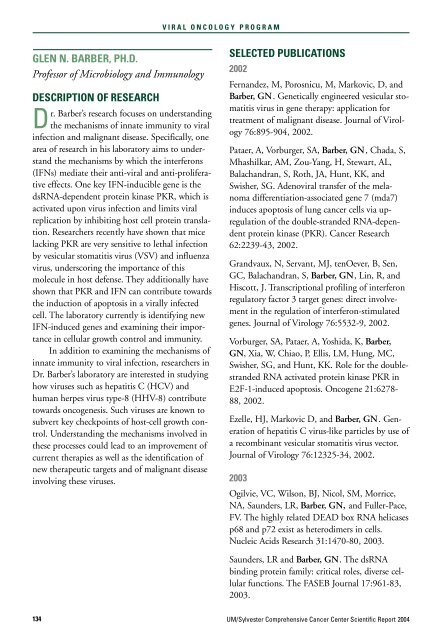SCIENTIFIC REPORT 2004 - Sylvester Comprehensive Cancer Center
SCIENTIFIC REPORT 2004 - Sylvester Comprehensive Cancer Center
SCIENTIFIC REPORT 2004 - Sylvester Comprehensive Cancer Center
Create successful ePaper yourself
Turn your PDF publications into a flip-book with our unique Google optimized e-Paper software.
V I R A L O N C O L O G Y P R O G R A M<br />
GLEN N. BARBER, PH.D.<br />
Professor of Microbiology and Immunology<br />
DESCRIPTION OF RESEARCH<br />
Dr. Barber’s research focuses on understanding<br />
the mechanisms of innate immunity to viral<br />
infection and malignant disease. Specifically, one<br />
area of research in his laboratory aims to understand<br />
the mechanisms by which the interferons<br />
(IFNs) mediate their anti-viral and anti-proliferative<br />
effects. One key IFN-inducible gene is the<br />
dsRNA-dependent protein kinase PKR, which is<br />
activated upon virus infection and limits viral<br />
replication by inhibiting host cell protein translation.<br />
Researchers recently have shown that mice<br />
lacking PKR are very sensitive to lethal infection<br />
by vesicular stomatitis virus (VSV) and influenza<br />
virus, underscoring the importance of this<br />
molecule in host defense. They additionally have<br />
shown that PKR and IFN can contribute towards<br />
the induction of apoptosis in a virally infected<br />
cell. The laboratory currently is identifying new<br />
IFN-induced genes and examining their importance<br />
in cellular growth control and immunity.<br />
In addition to examining the mechanisms of<br />
innate immunity to viral infection, researchers in<br />
Dr. Barber’s laboratory are interested in studying<br />
how viruses such as hepatitis C (HCV) and<br />
human herpes virus type-8 (HHV-8) contribute<br />
towards oncogenesis. Such viruses are known to<br />
subvert key checkpoints of host-cell growth control.<br />
Understanding the mechanisms involved in<br />
these processes could lead to an improvement of<br />
current therapies as well as the identification of<br />
new therapeutic targets and of malignant disease<br />
involving these viruses.<br />
SELECTED PUBLICATIONS<br />
2002<br />
Fernandez, M, Porosnicu, M, Markovic, D, and<br />
Barber, GN. Genetically engineered vesicular stomatitis<br />
virus in gene therapy: application for<br />
treatment of malignant disease. Journal of Virology<br />
76:895-904, 2002.<br />
Pataer, A, Vorburger, SA, Barber, GN, Chada, S,<br />
Mhashilkar, AM, Zou-Yang, H, Stewart, AL,<br />
Balachandran, S, Roth, JA, Hunt, KK, and<br />
Swisher, SG. Adenoviral transfer of the melanoma<br />
differentiation-associated gene 7 (mda7)<br />
induces apoptosis of lung cancer cells via upregulation<br />
of the double-stranded RNA-dependent<br />
protein kinase (PKR). <strong>Cancer</strong> Research<br />
62:2239-43, 2002.<br />
Grandvaux, N, Servant, MJ, tenOever, B, Sen,<br />
GC, Balachandran, S, Barber, GN, Lin, R, and<br />
Hiscott, J. Transcriptional profiling of interferon<br />
regulatory factor 3 target genes: direct involvement<br />
in the regulation of interferon-stimulated<br />
genes. Journal of Virology 76:5532-9, 2002.<br />
Vorburger, SA, Pataer, A, Yoshida, K, Barber,<br />
GN, Xia, W, Chiao, P, Ellis, LM, Hung, MC,<br />
Swisher, SG, and Hunt, KK. Role for the doublestranded<br />
RNA activated protein kinase PKR in<br />
E2F-1-induced apoptosis. Oncogene 21:6278-<br />
88, 2002.<br />
Ezelle, HJ, Markovic D, and Barber, GN. Generation<br />
of hepatitis C virus-like particles by use of<br />
a recombinant vesicular stomatitis virus vector.<br />
Journal of Virology 76:12325-34, 2002.<br />
2003<br />
Ogilvie, VC, Wilson, BJ, Nicol, SM, Morrice,<br />
NA, Saunders, LR, Barber, GN, and Fuller-Pace,<br />
FV. The highly related DEAD box RNA helicases<br />
p68 and p72 exist as heterodimers in cells.<br />
Nucleic Acids Research 31:1470-80, 2003.<br />
Saunders, LR and Barber, GN. The dsRNA<br />
binding protein family: critical roles, diverse cellular<br />
functions. The FASEB Journal 17:961-83,<br />
2003.<br />
134<br />
UM/<strong>Sylvester</strong> <strong>Comprehensive</strong> <strong>Cancer</strong> <strong>Center</strong> Scientific Report <strong>2004</strong>
















